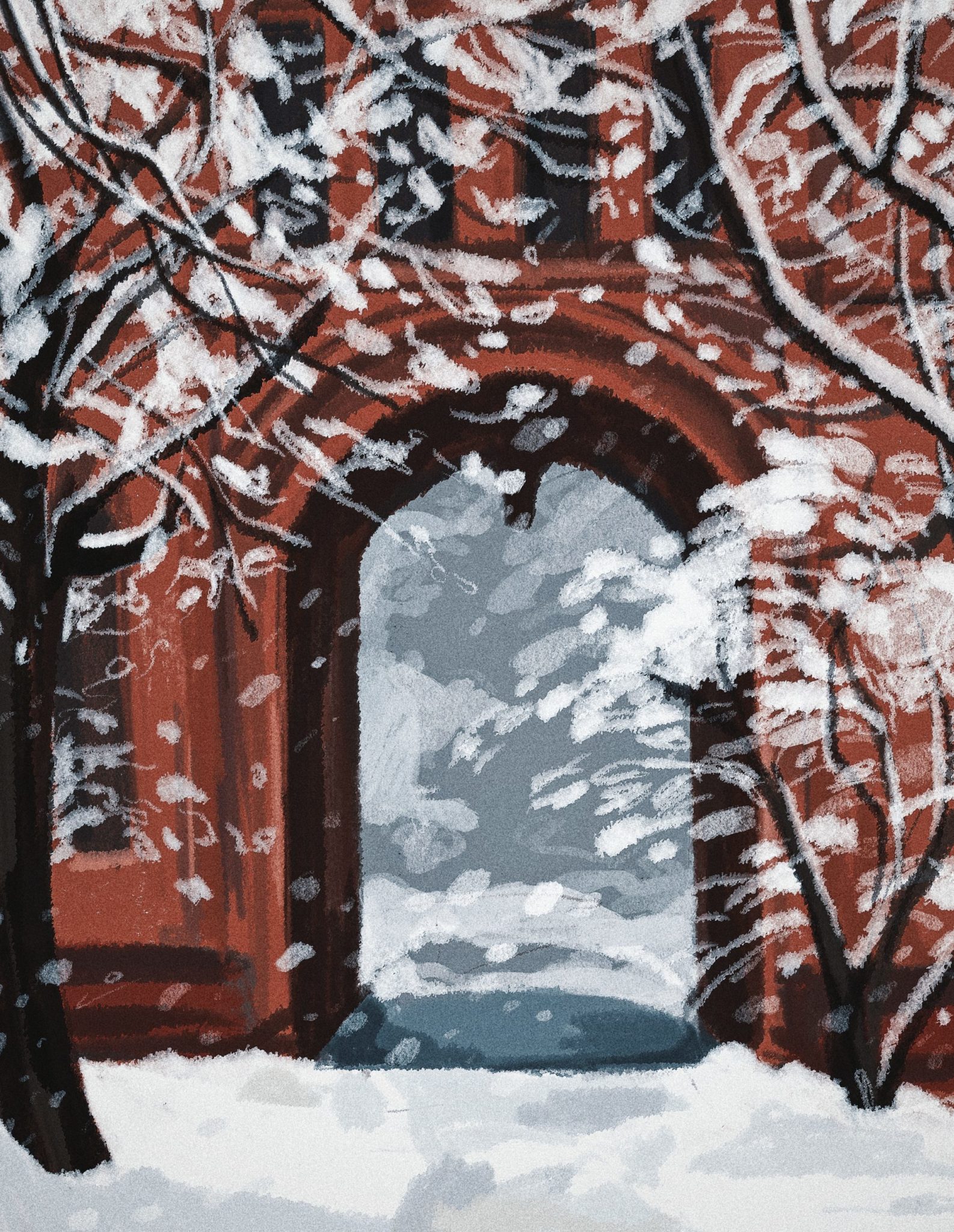
Sophia Zhao
This year I experienced winter for the first time. In Sydney — that oceanside city which I call home — the sun is constant and the beaches never empty. Freezing describes a cool coastal wind rather than water’s steady change of state in the atmosphere. I never owned a pair of gloves or boots and had never seen snow. Winter was that time in the northern hemisphere, I presumed, when the days were dim and lit only by lamplight. It would be cold outdoors but warm inside, and seasonal decorations would burst from buildings. Holiday cards and every movie I had seen promised evergreen garlands and lights on strings. People would move slowly in the streets. They would linger in stores and in doorways as snow piled on windowsills.
My winter did move slowly.
I remained in New Haven as the pandemic was peaking and America’s anxious democracy reeled towards collapse. For two months I lived on Old Campus, in a wood-clad dorm room straight out of the ’60s. Yale’s colleges darkened and shut their gates. Classes ended and my friends moved home. I called them often and my parents not often enough. I moved my plants from my bedroom to the window and then to the mantle and watched as they all wilted and died over several weeks.
There was a restlessness to the winter. I watched the news and read the headlines with cold fright. 150,000 new cases a day became 200,000 and then 250,000. 3,000 deaths daily. With all my spare time, I took to walking for hours around New Haven. In the evenings, I cut black paper into silhouettes and hung them on my walls.
By mid-December, I was colder than I had ever been before. Snow fell before the end of final exams. It was like sand, but lighter. At the end of the month, I left campus for a week-and-a-half to visit a friend in western Massachusetts. In the Berkshires, I re-entered the quiet sanity of family life: driving in a car, setting the table, playing board games where points were tallied on sheets of paper with the initials ‘M,’ ‘S’ and ‘O’ standing for names
While all this was happening, Australia once again entered summer. When I called my old friends from home, they were wearing T-shirts and ponytails to keep hair off their necks in the heat. This time of year in Sydney is usually unhurried and lethargic. By early December, schools release their swarms of children into the city. They crowd trains to the harbor and buses to the beaches. Picnickers drink and lie for hours in the shade of fig trees. Windows are left open so that from the street you might hear the chitchat of a private life or glimpse PVC plastic Christmas trees in the living room. It was this wonderful laziness of the Australian summer that I longed for in my own unsettled winter.
I asked my friends about their summers. Were they going to the beach? Not really. In fact, they rarely saw each other. Lockdown in Sydney was lifting once more, and community transmission was virtually nonexistent. But the routine of the pandemic remained. My friends told me they had been ‘on pause’ for the last year. Like me, they fell into small obsessions and seemed unable to move forward. The summer had not relaxed them. Instead, a lack of anything to do had agitated them as they became increasingly aware of how much time was passing.
They were in summer and I in winter. It seemed my condition was not unique to the weather or continent. Across the Pacific, we had all succumbed to a similar unease. We were in stasis, but restless. Were we just getting older?
As Shakespeare’s “Richard III” ominously begins, ‘Now is the winter of our discontent.’ While I can hardly stand the play after a year of high school study, I have always liked that line. There was certainly something wintery about the discontent and discontent about the winter. Since the pandemic infiltrated our daily lives, we have all been in a sort of winter-state. Sitting in white rooms in our cold cathode light, rarely venturing outside, and seeing no one. All year we have been in winter. It took over the country, the world, while I was conjugating French verbs and pretending to be busy.
And where was the end of this winter? The pandemic raged and attackers stormed the nation’s capital on the eve of a new presidency. How could we return to a new year and enter the same world after all this? It preoccupied my mind over the winter break.
After an hour of being melancholy and blasting The Carpenters in my dorm room, I went out walking. I passed around the Divinity School and came back down Saint Ronan Street. Behind the Sterling Divinity Quadrangle, a hill covered in snow sloped to the road. Pairs of children lugging colorful sleds climbed past me to the top of the hill. People bundled in scarves and coats slid down and laughed, losing a hat or glove on the way.
Parents stood at the bottom of the hill. Even long after the cold became harsh, the children were endlessly joyful. The sun was setting and streetlights were turning on. The scene was straight out of a holiday card. Despite the inertia of the winter and the restlessness of the year, there would always be another tireless generation marching up the white hill. They sledded down and raced back up. Then they came down again, back to parents who grabbed their mittened hands and pulled them out of the snow, towards home.
Margot Lee | margot.lee@yale.edu







